





| Soviet M91/30 All content copyright © 7.62x54r.net Return to Models Introduction |
Overview
In 1930 updates to the Dragoon were adopted and the "new" rifle was designated the "7,62 mm Rifle, Model of the Year 1891-30", more commonly known in the US as the M91/30. Changes included the front and rear sights and split barrel bands. Hexagonal receivers were phased out and replaced with round receivers in 1935 and 1936 respectively at Izhevsk and Tula, the two arsenals which produced the 91/30. Many rifles dated prior to 1930 are found in M91/30 configuration but retain the original markings on the barrel shank with dates prior to 1930. This is from programs, primarily post WWII, to update older rifles by the Soviets and they are known among collectors as "ex-dragoons". Primary production ended in 1944 with few examples, mostly snipers, dated later. M91/30s were used as the basis for sniper rifles from the mid-'30s with several types of mounts and scopes. The most commonly encountered today is the PU which was adopted in 1942 and uses a side rail mount.
Variations and Features to Look For
The variety among M91/30s is great due to its long time in production, the large numbers produced during WWII, and its wide ranging use both during WWII and afterwards. While it would be impossible to list every possible combination of features and marks, an attempt will be made to cover the more desireable ones to aid new collectors.
Arsenals and Dates Only two arsenals built M91/30s in the Soviet Union, Tula and Izhevsk. While Tula is preferred by some collectors over Izhevsk there is no concrete reason for this. Although the degree of finishing suffered slightly more at Izhevsk during WWII the strength of the rifles was not compromised and there is no evidence, anecdotal or otherwise, that rifles from one arsenal are any more accurate than the other. Although full production began in 1930 and ended in 1944 at both arsenals there are many M91/30s on the market with earlier dates. These were originally built as Dragoon rifles from 1893 to 1929 at Izhevsk and from 1923 to 1929 at Tula. Dragoons were also built alongside M91/30s up to 1932, but that is outside the scope of this article. Some Dragoons were likely upgraded to M91/30 specifications prior to WWII but the vast majority were upgraded during the last major refurbishments of Mosin Nagant rifles carried out in the 1960s and 1970s. It's also possible some were upgraded by Finland. Collectively these are commonly known as "ex-Dragoons" and the original barrel marks are typically retained. Similarly there are "ex-Cossack" rifles which are considerably less common than ex-Dragoons and would be considered a prize in a collection. Most ex-Dragoons will be dated in the 1920s, but they are known as early as the 1890s with the older the date the less common and more desirable the rifle. Dragoons and M91/30s share a common barrel length, within a small fraction of an inch, which made the upgrade as simple as changing the front and rear sights. Because M91s are longer they were not typically upgraded to M91/30 specifications, although a few instances have been documented. Any M91/30 with a Chatellerault, Sestroryetsk, Remington or New England Westinghouse barrel was originally an M91 and very uncommon. Of course Tula and Izhevsk M91s could also have been cut down to M91/30 configuration. Regardless of the arsenal these often show evidence of the cut down such as a noticeably turned down barrel near the muzzle so the socket bayonet would fit and welding or brazing of the front and rear sight bases. However, without very compelling evidence any pre-1930 dated Tula or Izhevsk M91/30 should be considered an ex-Dragoon rather than an ex-M91. Among the typical M91/30 production dates there are a few which are less common. Production was much lower in the early 1930s than it was during WWII, but none of the 1930s dates are considered particularly rare. Although production at Tula during 1941 is documented to have been approximately 900,000 rifles for some reason very few have turned up in the US. While an anomaly like this might not interest some collectors, those who collect by years would be glad to find a 1941 Tula. Some sources don't report any production at Tula during 1943 and 1944, but both years are relatively common. Tula M91/30s dated after 1944 have been reported up to at least 1948 and any of them would be a good find. Prior to WWII Izhevsk production was lower than Tula but during WWII it was not pressed as heavily by Germany and production was astronomical. 1942 and 1943 dated Izhevsk rifles can seem to be the majority of the recent imports and unless there is another compelling reason to buy one they are nothing to get excited about. Izhevsk did produce rifles in 1945, but they are uncommon as are any later dates, reported into the early 1950s.
Receivers There are many minor receiver variations, especially during WWII, but only two major configurations, hex and round. Hex receivers were standard from the beginning of M91 production and used for M91/30s until 1935 at Izhevsk and 1936 at Tula. 1935 was a low production year at Izhevsk, but serial number evidence appears to point to the hex receiver being the less common. 1936 Tula receivers are split almost equally between hex and round. A significant number of older receivers were used to build new rifles at both Izhevsk and Tula. This would be the case with any post 1935 dated Izhevsk or post 1936 dated Tula M91/30 with a hex receiver. These receivers were not "old stock" but were stripped from damaged or worn out rifles. Dates and arsenals, which are typically found on the bottom of the tang by removing the action from the stock, run the gamut of all M91 production and the specifics are not important with the exception of antique/non-firearm status (1898 or earlier) under US law and this only for purposes of shipping and transfers among non-licensed individuals. Early production receivers are often not marked or dated so exact specifics can't always be determined. New England Westinghouse receivers are not dated but would have been made from 1915 to 1917. A number of 1941 Izhevsk M91/30s on hex receivers have been documented and 1943 and 1944 hex receiver Tula M91/30s are not considered rare by any means. Any of these are a good find though and demonstrate the need to make use of any possible resources during WWII. The most well known minor receiver variation is known as the "low wall/high wall". Low wall receivers have the left side adjacent to the feed/ejection port milled down at an angle to reduce weight. This area was left unmilled for the purpose of mounting scope bases for sniper rifles beginning with the PEM side rail mount in the late 1930s. For a time during WWII both Izhevsk and Tula left this area unmilled on standard infantry rifles also. This feature, or the lack thereof, is not considered important to most collectors and usually has no bearing on the value of a particular rifle. However, for some who study and collect receiver variations it is important and a low wall receiver on a rifle dated during high wall production can be an indication that it is an earlier receiver, even if its basic shape is round and not hex.
Ex-snipers After WWII many Soviet sniper rifles were converted to standard infantry rifles by removing the scopes and mounts, welding plugs in the mount holes, patching or replacing the stocks, and replacing the bent bolt handle. Tula marked Sniper rifles with a large Cyrillic "S P" (early) and "S N" (late) on either side of the top point of the star on the barrel. Izhevsk did not use a similar mark, but did place the serial number of the scope along the woodline of the left side of the barrel. These marks and the plugged mount holes are the easiest way to tell if a rifle is an ex-sniper. Some Tula rifles have the sniper marks, but don't show any evidence of ever having a scope mount attached. These are probably a case where a rifle was deemed accurate enough for use as a sniper and marked, but sniper production quotas were met before it was needed or it failed some other test later in production. Early PE top mounts can be difficult to see as the plugged holes are forward of the feed/ejection port, but in most cases a close look under strong light shows evidence of the welding and grinding on the outside of the receiver. Just as with original snipers the earlier ex-snipers are less common than later ones. To most collectors any ex-sniper is simply a curiosity with little premium value placed on its former status.
Stocks M91/30 stocks come in 4 major variations as pictured below on this page. Any of the stock types can be found on any date rifle due to the refurbishment process where stocks were replaced or reused on other rifles. The early stocks have sling slot escutcheons which are held on with two small screws each. They would be "correct" until roughly 1941 and are a minor "bonus" on earlier rifles, and even later ones, although obviously not original. During WWII the rear sling slot escutcheon was eliminated and the front one was converted to a sheetmetal liner in the bottom of the slot only to save material and labor in production. While production would have been high, so was attrition and these are not much more common than the earlier stocks among recent imports. Post war stocks have full escutcheons both front and rear but they are pressed into the stock rather than screwed on. These are replacement stocks and many are in "new" condition. No premium should be placed on these. Laminated M91/30 stocks, also post-war replacements, are much less common than solid or "hardwood" stocks and do bring a premium. Although seemingly plentiful on the current market, in reality the numbers are small and they can be expected to go up in value. All stock types can have a variety of repairs and most don't bring a premium or hurt the value of a rifle. Some of note are cases where a hardwood stock has a spliced toe of laminated material or vice versa and stocks with a distinctive "zig zag" splice just behind the rear barrel band or in the fore end. M91/30 handguards don't have much variation except in the type of material used for the end caps. Copper, brass, steel and possibly zinc or aluminum were all used at different times. Copper was the earliest followed by brass. Both of these are somewhat uncommon, but don't add a lot of value. Steel is typical for wartime production and is found on most rifles today. Any of these can be covered with black paint from the refurbishment process so it pays to look close if you are in the market for a copper or brass capped handguard.
Sights and Barrel Bands Early M91/30 front sights were a tall blade front sight which was replaced with the common post and globe. Most were upgraded and are scarce now. A few have been imported with the correct Panshin bayonet which has an integrated sight hood and is worth two to three times the value of the rifle itself. If an M91/30 with a blade front sight is encountered every effort should be made to determine if it is accompanied by a Panshin bayonet and purchased immediately. Other minor changes in sights are detailed below but don't mean much as far as value or rarity are concerned. Barrel bands are divided into three major variations. Solid bands were used on Dragoons, but can be occasionally found on M91/30s, although incorrect. Early "button bands" are uncommon and an interesting find. Split bands are typical.
Marks There are a wide variety of unknown marks found on Soviet M91/30s. Some of the more desirable are the East German (DDR) "triangle 1", Soviet MO double and triple dates, "YY" training rifle marks, and XO-46, XO-47, XO-48 marks. "Triangle 25", and "PM" marks are unknown, but relatively common. "PM 86" is another unknown mark, but seems to run in a particular serial number range in early 1934 at Izhevsk and would be worth picking up for the right price. P/LAMB/44r is also unknown and turns up occasionally as does "P" followed by several different numbers. Marks associated with particular countries are covered below. Due to heavy reworks and sanding during refurbishment clear arsenal marks are seldom found on M91/30 stocks and are a nice bonus. On the other hand, there are numerous Cyrillic letters and numbers found alone or in circles, squares, and triangles with unknown meanings which don't add any value to a rifle other than as a curiosity.
Other Countries Soviet M91/30 rifles were also used by a number of
different countries and can often be identified by additional marks or simply
conditions and features unique to these countries. In general these are less
common, more desirable, and more valuable than typical Soviet refurbished
rifles. Several other countries built their own M91/30 rifles, but they are
outside the scope of this article and will be covered on their own pages.
However, there can be some "crossover" where an M91/30 from another country
somehow ended up in the Soviet Union where it was refurbished and exported to
the US. A Hungarian made M91/30 was recently imported from Ukraine in a post
WWII Soviet stock in typical refurbished condition. One explanation is that it
was picked up by the Soviet Army during the Hungarian Revolution of 1956 and
taken back to the Soviet Union proper and simply added to existing M91/30
inventory. While a rifle like this might not be as valuable as an original
Hungarian M91/30, with little to no sales history on the open market its
difficult to say, it is certainly more valuable than a typical Soviet M91/30 and
an interesting piece of Cold War history.
Finland The most commonly found Soviet M91/30s used by another country
are from Finland. The best known identifier is the SA mark
typically found on the left side of the barrel along the woodline, although
occasionally in other locations on the barrel shank. Other
Finnish marks include "PUOLUSTUSLAITOS",
"D", and "41". Stocks on Finnish/Soviet M91/30s can be Soviet, Soviet with a
spliced Finnish fore end, or completely Finnish. Miscellaneous parts and
features vary greatly due to the number of early parts on hand in Finland used
for repairs. Serial numbers on the floorplate and buttplate are typically
mismatched and should be expected. Bolts are typically re-numbered either on the
body or the knob. Despite this "parts gun" character Finnish marked Soviet
M91/30s are very desirable and more valuable than the typical refurbished
import. There have also been several cases of Finnish marked M91/30s being
imported from Ukraine in refurbished condition. These would have been captured
from the Soviets during the Winter or Continuation War, marked, and subsequently
recaptured by the Soviets and placed back in inventory. They are much less
common than rifles marked by Finland which stayed in Finland and should command
a slight premium. They are certainly a "must buy" when sold at the going price
for Soviet refurbs which they often are.
Spain During the Spanish Civil War the Soviet Union supplied arms,
including M91/30s, to the Republican forces. These were exported to the US in
the 1960s and were some of the first Mosins seen by US collectors. Condition
varies greatly and similar to Finland they can have a mix of parts including
incorrect front sights. Many were marked "MADE IN USSR", or oddly "MADE IN
URRS", by the importer and this is a dead giveaway of Spanish origin as no other
imports were marked in this way. The Spanish MP8/flaming bomb
mark is another identifier. Less common even than Finnish marked Soviet
M91/30s, Spanish M91/30s are an interesting part of any Mosin collection.
Germany While Germany did capture many M91/30s during WWII they did not typically mark them in any way and any "German or Nazi marked" M91/30 found
on the US market should be viewed with great suspicion considering the
proliferation of fake German stamps. Germany sold or gave many of the captured
M91/30s to Finland and presumably the Soviets recaptured many more late in the
war with none being imported to the US directly from Germany. There are
East German marked M91/30s, but these were
provided by the Soviet Union during the Cold War and subsequently returned to
the Soviet Union where they were refurbished and later exported among the
thousands of other rifles.
Latvia A little known and uncommon series of marks is found on a few
Soviet M91/30s. Known examples are "F.L.P. Riga" and "F.L.P. Mi.". The first
observed examples were stamped along the woodline of the receiver, but recently
they have been found lightly electropenciled on the top of the receiver. While
the exact meaning and purpose of the mark is up for debate it is almost
certainly associated with Latvia during WWII, likely with a German connection of
some kind. These rifles have been imported to the US both from Finland and the
former Soviet Union.
Romania A number of Soviet M91/30s were given to Romania after WWII where
they were relegated to "INSTRUCTIE" or
training status. While condition is typically poor they are an interesting
variation and easily recognizable due to the distinctive red band and lettering
on the butt stock. Some Soviet M91/30s from Romania will not be INSTRUCTIE
marked but can be identified by a distinctive
splice in the stock.
Condition, Originality, and Serial Numbers Just as with any collectible item, condition and originality are very important. Ironically some of the most original Soviet M91/30s seen in the US have been imported from Finland. As mentioned above the Finnish M91/30s can have a mix of parts, but some are virtually untouched other than the SA mark. The common recent M91/30 imports from Ukraine have all been refurbished during the 1960s/1970s, whether they have a "refurb mark" or not, and therefore lack a good bit of originality. However, some are "more original" than others. Replacement stocks, covered in detail above, are something of a detriment as are renumbered parts. This can be offset by uncommon marks or other features, but when selecting a rifle, all else being equal, the more original the better. Serial numbers should be examined closely to determine if they are orginal to the rifle. Some obvious signs that they are not is a parts mark from an arsenal other than the one the rifle is from, signs of grinding off of an old number, the presence of an old number which is struck through, electropenciled numbers, and the absense of the two letter prefix when it is found on the barrel (post 1937/38). Even some stamped marks on "clean" parts from the correct arsenal with the full prefix are not original. In this case the font of the letters and numbers should be closely compared to the ones on the barrel. If they are not exactly the same, then they are not original.
Import Marks Obviously a firearm without an import mark is more desirable than one with an import mark. While import marks are a fact of life under current US law that must be accepted there is a great range in the subtlety of marks from different importers. Some collectors simply will not accept a firearm with a large garish mark, but a hard and fast rule against them can rule out some interesting rifles. A subdued and inconspicuous mark is always better, but there are many more important things to consider when buying a firearm.
Barrel Condition and Price These are outside the scope of this article but are covered briefly here.
| Click on the images below for M91/30 shirts | |||||
 |
 |
 |
 |
 |
 |
| Specifications For all models see the Mosin Nagant Rifle Specifications page. |
||||||
| Weight | Over All Length |
Barrel Length |
Stock Length |
Groove Diameter |
Sight Radius |
Cleaning Rod Length (approx.) |
| 8 3/4 lbs. 4 kg. |
48 1/2" 123.2 cm. |
28 3/4" 73 cm. |
45" 114.3 cm. |
.311" | 24 1/2" 62.2 cm. |
26 1/4" 66.7 cm. |
| Years of Production by Arsenal For all models see the Mosin Nagant Rifle Years of Production page. |
|
| Tula | Izhevsk |
| 1930 to 1944 with minimal production into the early 1950s | 1930 to 1945 with minimal production into the early 1950s |
| Barrel Markings The dates are when the marking was used. |
|
Tula 1930-1944 |
|
| Receiver Tang Markings | |
Tula Star and date |
Izhevsk Arrow in Triangle and date |
| Stock Variations See the Mosin Nagant Rifle Soviet Stock Feature Relationships page for details on stock variations. | |
| Pre-war stock | |
| War-time stock | |
| Post-war stock | |
| Post-war laminated stock |  |
| Other Country's Variations See the Models section for variations manufactured by other countries. Follow the link for detailed information on the rifle. | |
| Romanian Cold War era Instructie training rifle |
 |
| Receiver Variations See the Mosin Nagant Rifle Receiver Variations page for a detailed comparison of secondary receiver features. | |
| Hex receiver 1930 to 1935 at Izhevsk 1930 to 1936 at Tula |
|
| Round low wall receiver 1935 to 1941 at Izhevsk 1936 to 1941 at Tula |
|
| Round high wall receiver 1941 to 1945 at Izhevsk 1941 to 1944 at Tula |
 |
| M91/30s may also be found built on reused older hex and round receivers. | |
| Early Nose Cap squared off front end |
Late Nose Cap rounded front end |
| Sling slots | Front | Rear |
| Pre WWII | 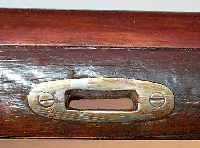 |
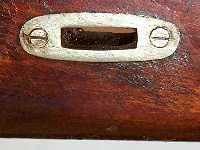 |
| Early WWII | 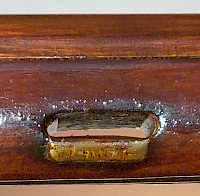 |
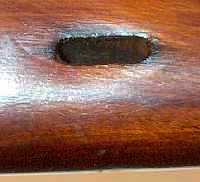 |
| Late/Post WWII | 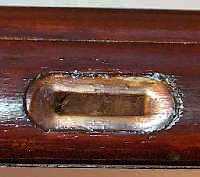 |
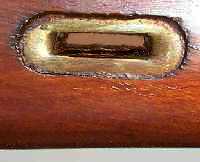 |
| Barrel Bands | |
| Button band 1930-1932 | Split band 1932-1945 |
| Handguard |
| Bayonet Socket |
| All content copyright © 7.62x54r.net Return to Models Introduction |